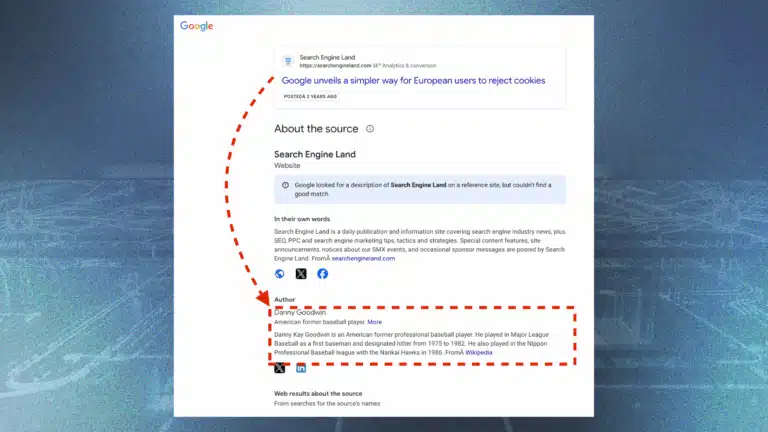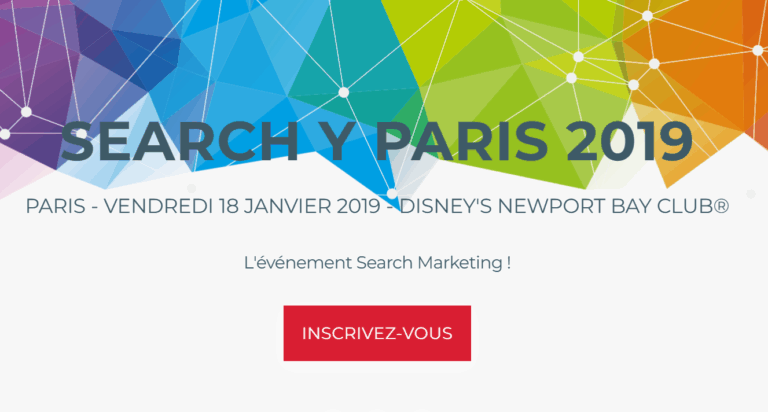The entity SEO fix that separated two Danny Goodwins

Article by Jason Barnard, published by Search Engine Land
A name mix-up in Google’s Knowledge Graph sent credibility to the wrong Danny Goodwin. Here’s how it got untangled.
For over a decade, Google’s search results and Knowledge Graph treated “our” Danny Goodwin - the editorial director of Search Engine Land and SMX - as the same person as the Hall of Fame baseball player who shares his name.
This is a worst-case scenario for entity optimization and knowledge panel management: a self-reinforcing algorithmic mix-up, complicated by a very famous namesake with a Wikipedia page.
The situation was severe:
- No presence in the Knowledge Graph.
- No Knowledge Panel.
- Articles attributed to the baseball player.
About a year ago, I took on one of the toughest entity optimization challenges I’ve seen:
- Separate “our” Danny from the other Danny Goodwin.
- Get him his own place in the Knowledge Graph.
- Build a rich, accurate Knowledge Panel.
- Ensure Google attributes his articles to the correct person.
- And eventually, untangle the confusion in AI Mode.
This article breaks down how that transformation (almost fully) happened - and what it took to get there.
A note on entity ambiguity
In entity optimization for individuals, the biggest challenge is usually name ambiguity - most people share their names with others.
For Goodwin, there are thousands, including a standup comedian, a university professor, and a Hall of Fame swimmer.
In his case, the challenges ran deeper:
- The standard ambiguity problem.
- A famous namesake.
- An entanglement in which Google treated two people as one.
- The biggest barrier was a decade of reinforcement in Google’s Knowledge Graph, which made the confusion increasingly difficult to unwind.
A case of mistaken identity - at scale
Google was absolutely convinced that Danny Goodwin, the baseball player, was the same person as Danny Goodwin of Search Engine Land.
To a human, it’s obviously absurd.
But Google’s Knowledge Graph algorithm relies on the “weight of probability” drawn from public information it can find, digest, and decode.
And in this case, the weight of probability suggested that Goodwin had somehow skipped 20 years and transitioned from professional baseball to SEO.
Google had maintained this belief for at least a decade.
As revealed in the 2024 Google leak, the Knowledge Graph feeds itself with its own synthetic data, reinforcing its existing assumptions over time.
When those assumptions are correct, the algorithm’s understanding becomes impressively strong.
But when they’re wrong, the errors compound until they become exponentially harder to fix.
This was a machine confidently telling itself the wrong story for years.
Undoing that self-reinforcing misunderstanding across dozens of updates is one of the most difficult challenges in knowledge panel management.
The most visible symptom: the misattribution of Goodwin’s articles.

This About this result snippet from October 2024 illustrates the issue. (Note: Our tool tracks historical data like this - though our system occasionally misreads special characters.)
This kind of confusion directly undermines E-E-A-T - or what I call N-E-E-A-T-T: notability, experience, expertise, authoritativeness, trustworthiness, and transparency.
We know that Google:
- Recognizes isAuthor for author entities
- Assesses credibility across three distinct tiers:
- The content itself.
- The publisher (i.e., the website owner).
- The content creator (the author).
The impact becomes even clearer.
The misattribution completely severed the “content creator” link, redirecting all the brand equity from Goodwin’s work to the baseball player’s entity.
A 3-step knowledge panel strategy
The approach to fixing long-standing entity confusion in the Knowledge Graph is the same as building an entity from scratch - just slower.
It’s all about systematically providing Google’s algorithms with an unambiguous, consistent, and corroborated set of facts across the entity’s digital footprint.
It’s about patiently re-educating the machine. I often use the analogy of “teaching Google like you would teach a child.”
Step 1: Build an entity home to establish a single source of truth
The first step was to create a canonical, fully controlled source of truth.
Goodwin didn’t have an entity home, so we built one.
The simplest WordPress site is enough:
- No custom design.
- Slow-loading.
- Just two pages - the homepage and the About page.

Step 2: Write a clear executive summary to disambiguate
On the entity home, we included a biography that opened with a simple statement - a semantic triple:
- “Danny Goodwin (subject) is (predicate/verb) an Editorial Director (object).”
In short:
- “Danny Goodwin is Editorial Director of Search Engine Land & Search Marketing Expo - SMX.”
This gave the algorithm a clear, unambiguous fact to anchor on.
We kept it extremely simple. (Overcomplicating is a common mistake in knowledge panel management.)
Goodwin’s original description was already very clear, so we changed only what was strictly necessary.
The goal of the longer summary was to outline his experience, expertise, and authority in search marketing, with dates - crucial for disambiguating him from the baseball player.
Step 3: Update the digital footprint to create a corroboration loop
Next, we gave Goodwin a prioritized list of pages to update with a revised description and a link back to his entity home:
- His social profiles.
- Author pages.
- Any other online assets he controlled.
In parallel, my team updated relevant third-party sources that allow contributor editing.
This created a self-reinforcing loop of corroboration.
By echoing the same facts and linking to a central hub (the entity home), his digital footprint began sending a clear, consistent signal to Google.
Over time, with each crawl, that consistency built Google’s confidence that danngoodwin.info is the entity home for our Danny Goodwin - and that the information there is accurate and trustworthy.
You can compile a list of pages to update manually, although it takes a few hours.
We used our own tool to automate this by identifying and prioritizing the pages most likely to influence Google’s knowledge algorithms. (The 2024 Google leak confirmed the importance of isReferencePage).
In general, author pages tend to carry the most weight, so a good rule of thumb is to start with those - along with social profiles and key industry sites.
Other sources that are often influential include:
- IMDb.
- The Org.
- Crunchbase.
- Wikidata.
- Wikipedia.

At first glance, it might seem easy to guess which pages count as isReferencePage for an entity.
But these signals vary by entity, and well-known sources like Wikipedia or Crunchbase aren’t always as dominant as expected.
As of July, Wikipedia and Wikidata together account for just 12.15% of the 1.5 million unique URLs we’ve identified as reference sources for 7.7 million entities.
Note: This dataset is weighted toward corporations and entrepreneurs, so patterns may differ for musicians, authors, and others.
Get the newsletter search marketers rely on.
Sign me up!
Timeline to a Google Knowledge Panel
Google’s Knowledge Graph builds understanding and confidence gradually, so patience is essential.
For a person entity, once everything is properly set up, the typical timeline for earning a full Knowledge Panel ranges from 6-12 months. That depends on:
- How common the name is.
- How messy the digital footprint is.
- How much confusion already exists.
In Goodwin’s case, we expected a longer process due to the deep entanglement with the baseball player.
Still, the outcome came faster than anticipated. The results?
- 4 months to get a unique identifier and sprout (delayed due to the existing, entrenched mix-up).
- 6 months to generate the Knowledge Panel cards.
- 9 months to stabilize the description (though it appeared off and on starting around month six).
- 12 months to surface accurate People also search for results.
November 2024 (4 months)
We had a sprout and a place in the Knowledge Graph with the kgmid /g/11gbb7v3gp.

January 2025 (6 months)
As Google’s confidence grew, the Knowledge Panel blossomed.
We got Knowledge Panel cards on New Year’s Day 2025.

April 2025 (10 months)
Then a nice, long description Goodwin himself wrote in April 2025:

July 2025 (12 months)
People also search for, featuring “our” Barry Schwartz - not the psychologist.

Caveat
This process is rarely linear.
Week to week, Knowledge Panel elements can appear, disappear, and reappear unpredictably.
In this case, both the description and the cards were particularly volatile.
That said, once established, the panel typically becomes stable and reliable.
Reaching that point can take up to two years - though that timeline will likely shorten as Google’s systems evolve.
The final piece: isAuthor
The one remaining puzzle piece is the isAuthor attribution for Goodwin’s articles.
From the 2024 Google leak, we know how important this signal is and that Knowledge Graph updates happen in slow, iterative waves.
Google has already detached the baseball player from Goodwin’s articles (arguably the hardest part, given the entanglement).
However, isAuthor still doesn’t explicitly point to the correct Goodwin.
That alignment will likely fall into place gradually over the coming months.

Bonus win: Google AI Mode
We also saw a clear payoff in AI results.
When Google AI Mode launched, it immediately presented the two Goodwins as distinct entities.
That means the work had an impact across the full algorithmic trinity behind AI Mode (and all assistive engines):

That means the work made an impact across the algorithmic trinity behind AI Mode and all assistive engines:
- Knowledge Graph: We successfully established a new, distinct entity.
- Web index: Goodwin’s digital presence was clearly separated from the baseball player.
- LLM: Gemini now references both accurately in a single response.
Entity disambiguation is always possible
This was one of the trickier challenges I’ve encountered in 13 years of optimizing entities for Brand SERPs, Knowledge Panels, and now LLMs.
But it’s also a great proof point: even entrenched algorithmic confusion can be resolved.
With a structured, clear, and patient approach, you can teach the machine the facts and take ownership of your digital identity.






